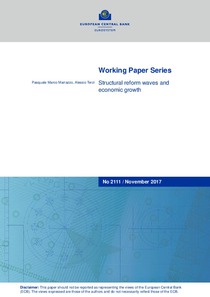Structural reform waves and economic growth

Marrazzo, Pasquale Marco ; Terzi, Alessio
ECB - Frankfurt am Main
2017
64 p.
structural change ; economic reform ; economic growth ; gross domestic product
developed countries ; developing countries
Working Paper
2111
Economic development
English
Bibliogr.;Statistics
"At a time of slow growth in several advanced and emerging countries, calls for more structural reforms are multiplying. However, estimations of the short- and medium-term impact of these reforms on GDP growth remain methodologically problematic and still highly controversial. We contribute to this literature by making a novel use of the non-parametric Synthetic Control Method to estimate the impact of 23 wide-reaching structural reform packages (including both real and financial sector measures) rolled out in 22 countries between 1961 and 2000. Our results suggest that, on average, reforms started having a significant positive effect on GDP per capita only after five years. Ten years after the beginning of a reform wave, GDP per capita was roughly 6 percentage points higher than the synthetic counterfactual scenario. However, average point estimates mask a large heterogeneity of outcomes. Benefits tended to materialise earlier, but overall to be more limited, in advanced economies than in emerging markets. These results are confirmed when we use a parametric dynamic panel fixed effect model to control for the rich dynamics of GDP, and are robust to a variety of alternative specifications, placebo and falsification tests, and to different indicators of reform."
Digital
The ETUI is co-funded by the European Union. Views and opinions expressed are however those of the author(s) only and do not necessarily reflect those of the European Union or the ETUI.